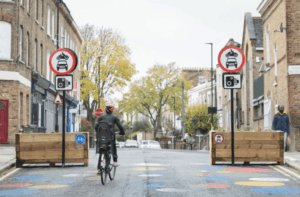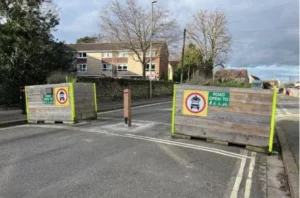Traffic data from 46 LTN scheme across 11 boroughs reported the mean percentage reduction of traffic on streets within them was 46.9%.
The study, which was conducted by the University of Westminster’s Active Travel Academy and was commissioned by climate charity Possible.
LTNs try to reduce motor traffic in residential areas by using either cameras, planters or lockable bollards.
The analysis looked at both internal roads within the LTNs and boundary roads, looking at the actual changes in motor traffic as well as what might have been expected based on previous London traffic trends, reports the BBC.
Many streets saw less than 1,000 motor vehicles passing through them a day.
BBC London transport correspondent Tom Edwards said: “What LTNs (or as they’re now called in some places Liveable Streets) try to do is encourage behaviour changes and get people to walk or cycle or use public transport by creating cul-de-sacs for motor traffic. The aim of that is to reduce emissions.
*But they have been very divisive in London and controversial. What this research shows is they have worked in getting people out of their cars, the traffic on the boundary roads – according to the research – hasn’t increased by the same amount it has dropped within the zone, i.e. people have switched modes.
“Nonetheless in London we still have a patchwork of councils with some like Islington and Lambeth expanding LTNs rapidly and others like Kensington and Chelsea not using them at all. Some like Ealing have pulled them out.
Whatever the research shows it is unlikely to change the mind of many. Views seem entrenched on this subject and the heated debate on who the capital’s residential streets are predominantly designed for, will no doubt rumble on.”
The LTNs studied were put in place between May 2020 and May 2021.
It found on internal roads, a mean baseline of 1,816 vehicles per day reduced to 964. Had the expected trend been followed, the count would have been 1,779.
The study also concluded LTNs did not lead to an increase or decrease in motor traffic on boundary roads, said the BBC report.
The report states: “Our findings suggest that LTNs can have an important role in reducing motor traffic on minor streets.”
However it added boundary roads (and other main roads for which LTNs were not suitable) urgently needed improvement as many such roads, which can see 11,000 motor vehicles use them a day, were hostile for walking and cycling and had poor injury and pollution records.
It added removing LTNs was unlikely to alleviate these issues.
Responding to the study, OneLondon, an umbrella group which represents more than 15 neighbourhood groups across London opposed to LTNs, said there were multiple flaws in the research.
In a statement, a spokesperson said: “The study notes that there were 96 schemes introduced but only 46 formed part of the study.
“Given councils may have chosen not to publish data for the worst-performing schemes, it would be hard to ignore the possibility of cherry picking or survivorship bias.”
The spokesperson also said methods used in the study were misleading, such as the use of percentage increases in traffic on boundary roads.
They argued a small percentage increase on busier roads could still represent a large number of vehicles being displaced from smaller roads, due to the overall amount of traffic on boundary roads.
OneLondon added: “Any improved analysis should not be restricted to groups marking their own homework – where those responsible for funding, campaigning for, or implementing schemes are the ones measuring their success.”
Shirley Rodriguez, London’s deputy mayor for environment and energy, said: “It’s absolutely key that we keep looking at the evidence for LTNs but it certainly confirms what we’re seeing at Transport for London in terms of the impact on road traffic reduction because of schemes like this and ULEZ, which is to the benefit of us all.
“LTN schemes where people feel they don’t work for them, the boroughs should be listening to them, the local authority leaders should be listening to their residents and then redesigning those schemes to make sure they do work and reflect those concerns.”





















